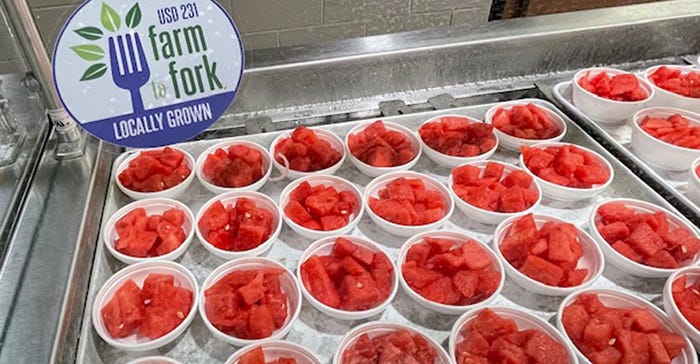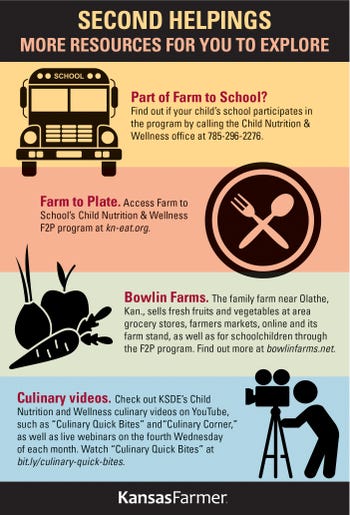April 1, 2022

Childhood nutrition has always been a top priority for school districts. But a push to add more local foods on Kansas school lunch trays is helping children, communities and farmers.
The trend to eat local is catching on in schools across Kansas. It’s happening in large and small districts, in rural and urban settings, including the Farm to Plate (F2P) program in Johnson County at USD 231’s Gardner Edgerton School District.
Working together, Amy Droegemeier, USD 231 director of nutrition services, and Steve Bowlin, a local farmer from Olathe, have created a successful plan that offers fresh produce to approximately 5,800 students.
Droegemeier believes that sampling is the key to expanding food preferences. Each month,, the 11 schools in her district feature a Harvest of the Month special: cruciferous vegetables in January, a variety of salad greens in March. Berries are featured in April, melons in August, apples in October and squash in November. Both common and unusual produce, such as arugula, are used, along with familiar and not-so-familiar preparation methods — including roasted apples.

During the start of the pandemic, USD 231 participated in the USDA Farmers to Families Box project. Picked up along with curbside meals, these boxes were so popular that the team created its own version for summer 2021. Boxes were filled with locally grown watermelons, cantaloupe, corn on the cob and tomatoes, plus ingredients for make-it-yourself smoothies, salads and salsas.
Barb Depew, Kansas Farm to Plate project director, points out that the F2P project falls under the Child Nutrition Program, a division within Kansas State Department of Education (KSDE). Most people have heard of the national Farm to School (F2S) initiative that connects K-12 schools with regional or local farms. In Kansas, the Farm to Plate name includes child and adult care programs as well as school nutrition programs and summer food service programs.
Filling plates with healthy, locally grown foods is the idea. Depew explains how a classic Kansas lunch menu, the much-loved chili and cinnamon roll combo, can include local foods from all of the different food groups:
Protein: beef and beans
Grains: cinnamon roll
Vegetables: tomatoes and onions
Fruits: fruit cup
Dairy: milk
Program scope
According to the latest 2018-19 USDA Farm to School Census, Kansas spent about $10.95 million in local food costs. With 686 Kansas schools serving local food, and 727 schools participating in F2S activities, a total of 327,243 students benefited from the program.
But the program’s scope goes beyond the lunch tray. Students also learn about local agriculture through lessons in their classrooms, on field trips — and even in some community gardens. Bowlin is working with Droegemeier to coordinate field trips to his farm.
“It will be a chance for kids to see, touch and feel the food they eat, and to understand where their food originates,” he says. They can see tomatoes and peppers growing on vines, blackberries on bushes, and that radishes and potatoes grow underground.
Across the state, in Stafford High School, students in the culinary program are learning how to cook with “local” at the forefront. Instructor Kim Unruh explains her classes have created a menu that features chicken fried steak and cream gravy — all using local, farm-raised, fork-tender beef and Hudson Cream Flour from the local mill, Stafford County Flour Mills in Hudson.
Becoming involved
Bowlin has been a force behind USD 231’s project, going above and beyond.
“He’s [Bowlin] served as a middleman, connecting us with other farmers when he doesn’t have the produce we need. In order to extend his growing season, he’s experimented with high tunnel plantings, allowing us access to early crops of lettuce, spinach and tomatoes,” Droegemeier says.
The Bowlin farm operates as a small family enterprise
“We started out with row crops, but it’s evolved to vegetables in the last 15 years,” Bowlin says. After meeting Droegemeier at a Land of Kansas workshop, they forged a working relationship that has prospered and grown over time.
Both Droegemeier and Bowlin have some advice to those who might be interested in providing food: “Don’t be afraid to reach out to a school district, and don’t worry if you can’t provide the full amount they need.”
Things just have a way of working out Bowlin explains. “Thanks to Amy, we will now also be providing produce to the Spring Hill School District,” he notes.
Anyone, from large-scale commercial commodity farmers to smaller-scale farmers — even local gardeners — can provide excess products, either through potential sales or donations.
For schools not already involved in the F2P program, Depew recommends bringing together producers, school board members, administrators, teachers, parents and community members to design their own plan that allows them to use what’s available locally. Many schools use their school wellness teams as the basis for their Farm to Plate involvement.
“It’s a win-win-win program,” Depew says. “Kids win with access to nutritious, high-quality local foods and enhanced learning about food, agriculture and healthy lifestyles. Farmers win by gaining a stable way to sell their goods locally and connect with the community. Communities win, since buying from local producers and processors creates new jobs, strengthens the local economy, and supports the health and wellness of community children.
Newell West lives in Abilene, Kan., but grew up on a farm in Stafford County in the state. A career educator, she taught home economics and family and consumer sciences at the secondary and adult levels. She continues to pursue educational endeavors as a freelance writer.
You May Also Like




